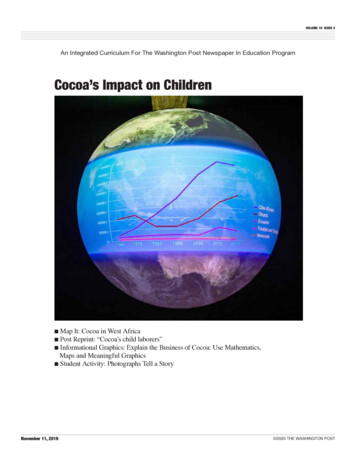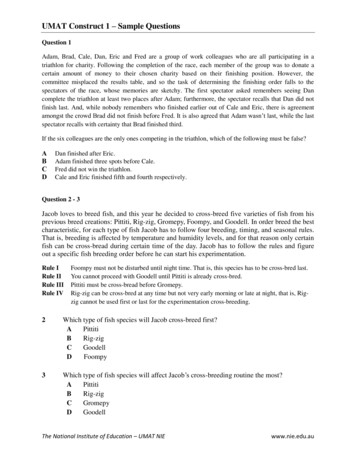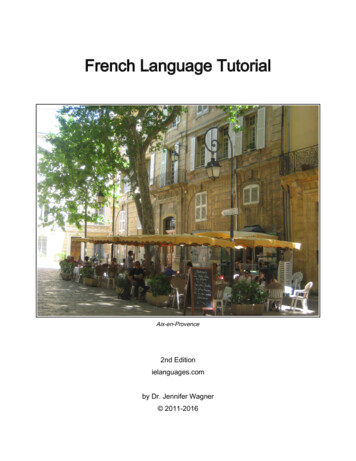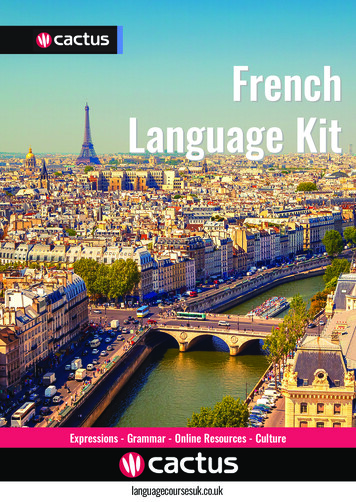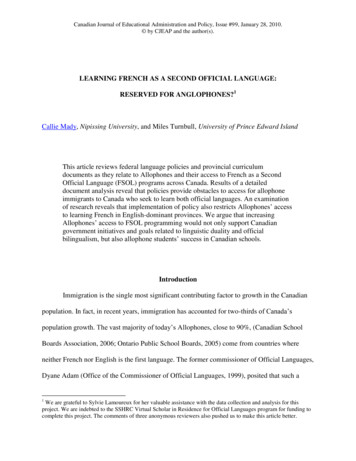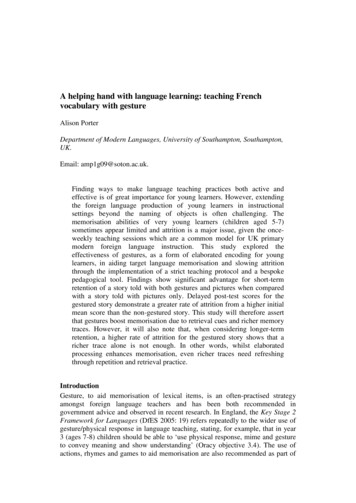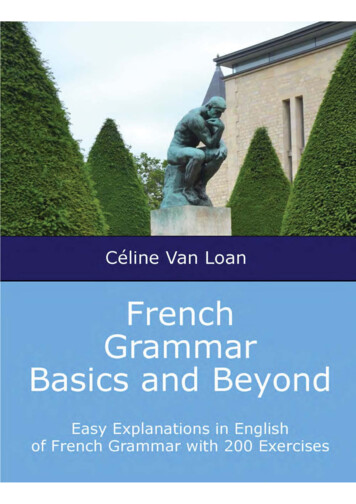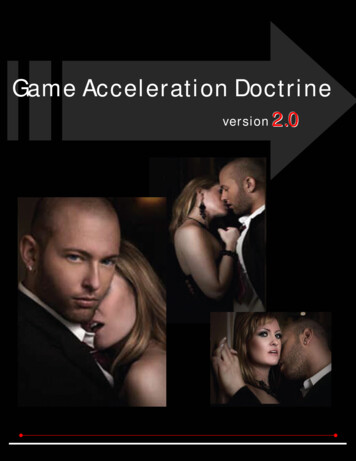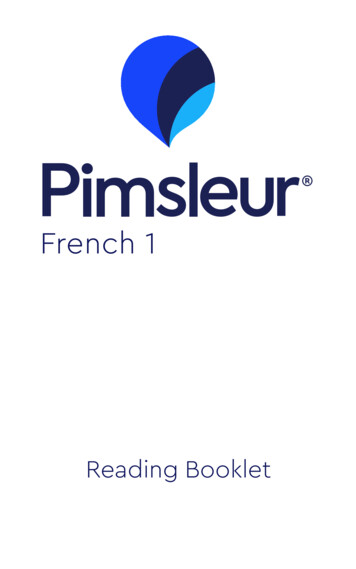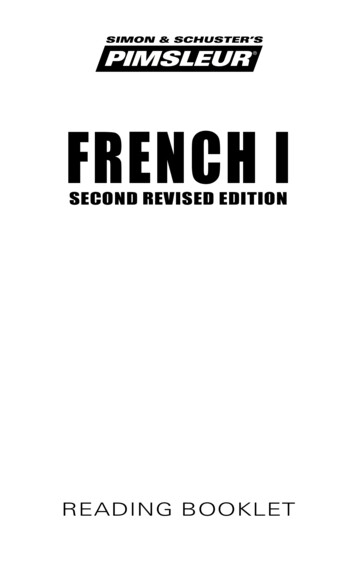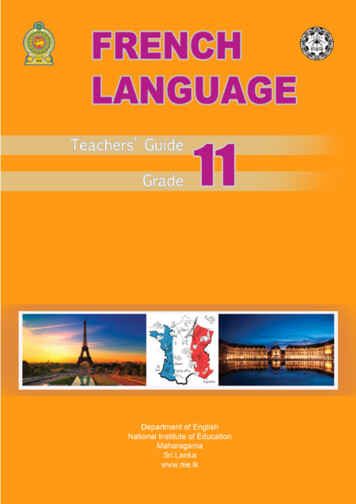
Transcription
French LanguageTeachers’ GuideGrade 11Department of EnglishFaculty of Languages Humanities and Social SciencesNational Institute of EducationMaharagamaSri Lankawww.nie.lki
Teachers’ GuideGrade 11First Edition2016ISBN- National Institute of EducationDepartment of EnglishNational Institute of EducationMaharagamaPrinted by :ii
Message from the Director GeneralThe first phase of the new competency based curriculum, with 8 years curriculum cycle wasintroduced to secondary education in Sri Lanka in 2007 replacing the existed content basededucation system with basic objective of developing the national level competencies recommendedby the National Education Commission.The second phase of the curriculum cycle to be introduced to grades 7 and 11 starts from 2016. Forthis purpose, National Institute of Education has introduced a rationalization process and developedrationalized syllabi for these grades using research based outcomes and various suggestions made bydifferent stakeholders.In the rationalization process, vertical integration has been used to systematically develop thecompetency levels in all subjects from fundamentals to advanced levels using the bottom upapproach. Horizontal integration is used to minimize the overlapping in the subject content and toreduce the content over loading in the subjects to produce more students friendly and implementablecurricular.A new format has been introduced to the teachers’ guide with the aim of providing the teachers withthe required guidance in the areas of lesson planning, teaching, carrying out activities andmeasurement and evaluation. These guidelines will help the teachers to be more productive andeffective in the classroom.The new teachers’ guides provide freedom to the teachers in selecting quality inputs and additionalactivities to develop the competencies of the students. The new teachers’ guides are not loaded withsubject content that is covered in the recommended textbooks. Therefore, it is essential for theteacher to use the new teachers’ guides simultaneously with the relevant textbooks prepared byEducation Publication Department as reference guides to be more aware of the syllabi.The basic objectives of the rationalized syllabi and the new format of teachers’ guide and newlydeveloped textbooks are to bring a shift from the teacher centered education system into a studentcentered and more activity based education system in order to develop the competencies and skillsof the school leavers and to enable the system to produce suitable human resource to the world ofwork.I would like to take this opportunity to thank the members of Academic Affairs Board and Councilof National Institute of Education and all the resource persons who have immensely contributed indeveloping these new teacher guides.Director GeneralNational Institute of Educationwww.nie.lkinfor@nie.lkiii
ForewordLearning expands into a wider scope. It makes life enormous and extremely simple. The humanbeing is naturally excellent in the skill of learning. A country when human development isconsidered the main focus uses learning as a tool to do away with ma lpractices identified withintellect and to create a better world through good practices.It is essential to create valuable things for learning and learning methods and facilities within thesphere of education. That is how the curriculum, syllabi, teachers' guides and facilitators join thelearning system.Modern Sri Lanka has possessed a self-directed education system which is a blend of global trendsas well as ancient heritage.It is necessary to maintain the consistency of the objectives of the subject at the national level.However, facilitators are free to modify or adapt learning teaching strategies creatively to achievethe learning outcomes, competency and competency level via the subject content prescribed in thesyllabus. Therefore, this Teachers' Guide has been prepared to promote the teachers' role and tosupport the students as well as the parents.Furthermore, at the end of a lesson, the facilitators of the learning-teaching process along with thestudents should come to a verification of the achievement level on par with ones expected exam by anational level examiner, who evaluates the achievement levels of subjects expected. I sincerely wishto create such a self-progressive, motivational culture in the learning-teaching process. Blended withthat verification, this Teachers' Guide would definitely be a canoe or a raft in this endeavor.Deputy Director GeneralFaculty of Languages, Humanities and Social Sciencesiv
Message of the Commissioner GeneralTeachers are leading personalities among those who render a great service for theprogression of the society. Teachers guide the children to mould their characters.The Educational Publications Department takes measures to print and publish theseTeacher Instructional Manuals to facilitate the teachers to carry out the teaching processsuccessfully in accordance with the new syllabi to be implemented with effect from 2015. Istrongly believe that this Teacher Instructional Manual complied by the National Institute ofEducation will provide the required guidance to create a favourable learning environment forthe children to learn.This venture will achieve its success on the effort made to utilize the experienceacquired by using this Teacher Instructional Manual in the teaching learning process. Ibestow my gratitude on all those who dedicated themselves for this national endeavour.W.D. Padmini NalikaCommissioner General of Educational PublicationsEducational Publications Department,Isusurpaya,Battaramulla.12.05.2016v
Syllabus CommitteeAdvice and Approval :Academic Affairs BoardNational Institute of EducationMaharagamaSubject Coordination:Hashini AbeysenaAssistant LecturerDept. of English, National Institute of Education, MaharagamaDirection:Darshana SamaraweeraDirector, Dept. of EnglishNational Institute of Education, MaharagamaPanel of Writers:Hashini AbeysenaAssistant LecturerDept. of English, National Institute of EducationMaharagamaDr.Subhashini PunchihettiPedagogy ConsultantAlliance Fransaise de ColomboMs.Irosha ChandrasekaraSenior LecturerUniversity of Sri JayawardenapuraMr.Chandeera GunawardhanaLecturer (Probationary)University of KelaniyaMs.Mihiri GunasekaraTeacher of FrenchJanadhipathi Balika VidyalayaRajagiriyaReview committee:Professor Sarath AmunugamaFormer Vice ChancellorUniversity of KelaniyaProfessor Niroshini GunasekaraSenior LecturerDepartment of Modern LanguagesUniversity of Kelaniyavi
Proof Reading CommitteeMs.U.G. ManoriTeacher of FrenchSamudradevi Balika VidyalayaNugegodaMs.Shyamalie De CostaTeacher of FrenchAnanda CollegeColombo 10Ms.Indeewarie PanditharatnaTeacher of FrenchViharamaha Devi Balika VidyalayaKiribathgodaMs. Kushani Dhananjala KankanamgeTeacher of FrenchSt Paul’s Girls’ School MilagiriyaColombovii
Instructions regarding the Teachers’ GuideThe first Competency based French Language syllabus for grade 11 which is to be implemented in2016 has 20 competency levels to be achieved by the students of grade 11. Grade 11 coursematerials consist of the Teachers’ Guide.This Teachers’ Guide consists of the detailed syllabus of grade 11, instructions for lesson planning,instructions for assessment and evaluation and web links given as further reference. They are quiteuseful in understanding and making the teacher familiar with a given competency level. Sampleactivities along with lesson notes that are useful to achieve the expected learning outcomes forrequired competency levels are also given in an integrated manner. Since the number of periods hasbeen notionally included, it is up to the teachers to plan the lessons accordingly based o n eachcompetency level and the outcome.Since the educational publication department is not involved in developing text books for thissubject the text books Tricolore Total (1&2) that are readily available in Sri Lanka , can be used toenhance the teaching Learning process. They are relevant to the new syllabi to a greater extent.Further, their attractive lessons, which motivate the adolescents to master the subject, with an up todate vocabulary and listening activities and a work book, are a conve nient source of reference toboth teachers and students in French language pedagogy. In addition to that, J.R.Watson’s (1 and 2),Apprenons le Francais (2 and 3),L’Esprit (1 and 2) and Dondo can also be recommended to teachersas further references enabling them for selecting activities creatively according to the level andinterest of students.Teachers are requested to expose their target language as much as possible so that it helps thestudents to improve their confidence in all 4 language skills; speaking, listening, reading andwriting. However, teachers have the opportunity to be creative and innovative, and prepare theirown lesson plans, so that their students will learn and acquire quickly and use their target foreignlanguage correctly as and when they are required to do so.Bonne Chance!Project Leaderviii
ContentPage1.Message from the Director General .iii2.Foreword . . iv3.Message of the Commissioner General .v4.Syllabus Committee .vi-vii5.Instructions for using the Teachers’ Guide . viii6.Content . .ix7. Contents of the Syllabus .x- xviii8. Instruction for the learning teaching processCompetency 01 . 1-2Competency 02 . 3Competency 03 . 4Competency 04 . 5-7Competency 05 . 8-10Competency 06 . 11-15Competency 07 . 16-17Competency 08 . 18-19ix
IntroductionRevised French Language syllabus for grade 11 is presented to the general education system of Sri Lanka based on thefollowing considerations.1. Retaining of the 8 key competencies introduced to the secondary French language curriculum in the year 2016.2. Presenting 20 specific competencies / competency levels identified as relevant and suitable for grade 11. Thedistribution of these competencies is given in the grid below.xCompetencyNo. of C. levels11.522.433.5,3.644.10, 4.11, 4.1255.4, 5.5, 5.666.8, 6.9, 6.10, 6.11, 6.1277.6, 7.7,88.10, 8.11, 8.123. Identification of learning outcomes expected at the end of the learning teaching process.4. Presentation of basic guidelines and limits of the content for teachers and material developers.In designing the grade 11 syllabus no particular FLT approach was followed, though the CEFR (Common European Framework ofLanguage Learning) was specially considered and therefore, teachers, teacher educators and administrators are requested to beinnovative and independent to select the best possible methodology to achieve success in teaching and learning French as a foreignlanguage. Moreover, the teachers and material developers are requested to pay heed to achieve national goals and competenciesthrough teaching of French Language in Sri Lanka to ensure sustainable development within a peaceful and multilingual world.
National GoalsNation building and the establishment of a Sri Lankan identity through the promotion of national cohesion, nationalintegrity, national unity, harmony, and peace, and recognizing cultural diversity in Sri Lanka’s plural society within aconcept of respect for human dignity.(ii)Recognizing and conserving the best elements of the nation’s heritage while responding to the challenges of a changingworld.(iii)Creating and supporting an environment imbued with the norms of social justice and a democratic way of life thatpromotes respect for human rights, awareness of duties and obligations, and a deep and abiding concern for oneanother.(iv)Promoting the mental and physical well- being of individuals and a sustainable life style based on respect for humanvalues.(v)Developing creativity, initiative, critical thinking, responsibility, accountability and other positive elements of a wellintegrated and balanced personality.(vi)Human resource development by educating for productive work that enhances the quality of life of the individual andthe nation and contributes to the economic development of Sri Lanka.(vii)Preparing individuals to adapt to and manage change, and to develop capacity to cope with complex and unforeseensituations in a rapidly changing world.(viii)Fostering attitudes and skills that will contribute to securing an honorable place in the international community, basedon justice, equality and mutual respect.xi(i)
Basic competenciesThe following Basic Competencies developed through education will contribute to achieve the above National Goals:(i)Competencies in CommunicationCompetencies in communication are based on four subsets: Literacy, Numeracy, Graphics and IT proficiency.Literacy:Numeracy:Graphics:IT proficiency:xii(ii)Competencies relating to Personality Development (iii)Listen attentively, speak clearly, read for meaning, write accurately and lucidly and communicateideas effectively.Use numbers for things, space and time, count, calculate and measure systematically.Make sense of line and form, express and record details, instructions and ideas with line form andcolour.Computer literacy and the use of information and communication technologies (ICT) in learning, inthe work environment and in personal life. Generic skills such as creativity, divergent thinking, initiative, decision making, problem solving, critical andanalytical thinking, team work, inter – personal relations, discovering and exploring ; Values such as integrity, tolerance and respect for human dignity; Emotional intelligence. Competencies relating to the EnvironmentThese competencies relate to the environment: social, biological and physical.Social Environment -Awareness of the national heritage, sensitivity and skills linked to being members of aplural society, concern for distributive ju
innovative and independent to select the best possible methodology to achieve success in teaching and learning French as a foreign language. Moreover, the teachers and material developers are requested to pay heed to achieve national goals and competencies through teaching of French Language in Sri Lanka to ensure sustainable development within a peaceful and multilingual world. Competency No .
